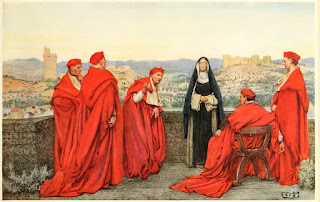Matilda did not take well to Stephen's usurpation. She was not, after all, an idle daughter waiting for her moment to shine: by this time, she was Empress Matilda by virtue of marriage to Holy Roman Emperor Henry V (shown above in a 12th century chronicle). (And who would believe it? Henry V tried to usurp the throne from his father, Henry IV.)
Henry V had died 10 years prior to the current crisis, but Matilda retained the title Empress. Her father recalled her to Normandy and arranged marriage to Geoffrey of Anjou to protect his southern border. (Blois was also on the southern border of Normandy; perhaps if he had arranged a different marriage...?) From here she could make plans to assume the English throne, kicking off a period called The Anarchy.
Stephen's reign was not without trouble. Not everyone approved of him personally, or of his seizing of the throne after pledging loyalty to Henry's daughter. In 1139 she left Geoffrey to conquer Normandy while she crossed the English Channel to take the throne from Stephen. She and her half-brother Robert of Gloucester visited her step-mother Adeliza, which caused Stephen to react. Afterward, she and Robert, with support from her uncle, King David I of Scotland, raised an army and captured Stephen at the Battle of Lincoln in 1141.
The next step was to be crowned at Westminster, but the people of London were against her and prevented it. She was never considered a Queen, not even for a moment. Her title in royal listings is Domina Anglorum, "Lady of the English." Stephen's supporters captured Robert, and Matilda agreed to exchange him for Stephen.
Although she had control over much of south-west England, Matilda returned to Normandy in 1148 (now under her husband's control), leaving her eldest son to continue the war. Other factors were at play: she was living in a castle that she took from the bishop of Salisbury; Pope Eugene III threatened her with excommunication if she did not return it.
The war became a stalemate, and the stalemate become the 1153 Treaty of Wallingford (or Westminster, or Winchester: all three are used), formally ending The Anarchy and agreeing that Matilda's son would become king upon Stephen's death, which obligingly happened a year later. Henry became King Henry II of England, starting the Angevin Empire.
I'd like to talk about the impact of the Angevin Empire next, but if you want more detail on The Anarchy you can check out posts from 10 years ago: Parts One, Two, and Three, along with this.)



























